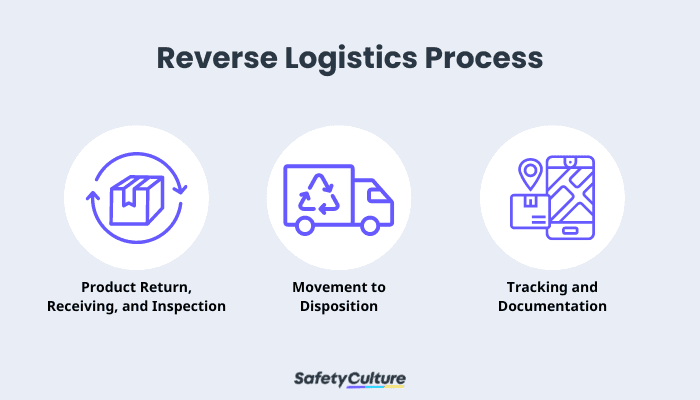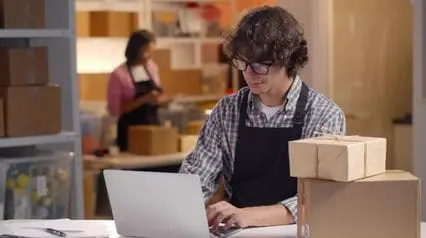What is Reverse Logistics?
As an important part of Supply Chain Management (SCM), reverse logistics refers to the process of movement of goods from the customer back to the manufacturer or supplier. This process is used to return, repair, or dispose of products that are no longer needed, wanted, or that can’t serve their intended purpose.
Reverse logistics is becoming increasingly important in today’s business environment. Companies are recognizing the need to manage their returns, recalls, and other defective products to help serve business goals and sustain efforts to become more sustainable. This is especially true in retail and e-commerce industries, where returns are a common occurrence.
Where It Applies
Reverse logistics is a process that is beneficial to many different types of businesses. Companies that manufacture and sell products, such as electronics, clothing, and furniture, can benefit from this approach. Retailers, wholesalers, and distributors can also use this process to manage their returns and exchanges. Additionally, Third-Party Logistics (3PL) providers can use it to provide services to their Business-to-Business (B2B) customers.
Also, this type of logistics approach can be used by businesses in the service industry, such as repair, maintenance, car rental, and equipment rental companies. They can use reverse logistics to manage the return of defective parts from the products that consumers rent.
Reverse Logistics vs. Traditional Logistics
Traditional logistics, also known as forward logistics, is when product flow starts with suppliers, moves on to a factory, production facility, or distributor, and then goes to the retailers and customers.
On the other hand, reverse logistics refers to the process wherein the goods come from the customers following an opposite direction towards any point or stakeholder in the supply chain.
Importance and Benefits
According to McKinsey, consumers in the United States returned goods bought online costing a total of $428 billion, with e-commerce returns accounting for almost a quarter of the returns volume. With these significant numbers, businesses must take steps to be accountable for such instances.
Having an effective reverse logistics system can provide notable benefits to businesses, such as the following:
Significant Cost Savings
By implementing a reverse logistics system, businesses can reduce the cost of returns and repairs, as well as the cost of disposing of unsellable products. Additionally, they can save money by reusing and recycling products rather than having to purchase new ones.
Improved Customer Satisfaction
By providing customers with an efficient and effective returns process, businesses can ensure that customers are happy with their purchases. This can lead to increased customer loyalty and repeat business.
Furthermore, businesses can use reverse logistics to provide customers with better customer service, such as providing replacement parts or offering refunds.
Reduced Environmental Impact
By reusing and recycling products, businesses can reduce their carbon footprint and help to protect the environment. In addition, they can use reverse logistics to reduce waste and increase efficiency, which can contribute to their efforts in sustaining and managing their overall environmental impact.
Also, it’s important to note that the benefits of reverse logistics can go beyond these, depending on how an organization’s supply chain is designed and maintained. It’s better to leave room to account for returns management.
Types
Reverse logistics can be divided into three main categories:
- Product returns – involve the return of a product to the manufacturer or retailer due to customer dissatisfaction
- Product recalls – involve the return of a product due to a safety or quality issue
- Product repairs – involve the return of a product to the manufacturer or retailer for repair or replacement
In addition to these three types of reverse logistics, some companies may use this logistics approach to redistribute products from one location to another. This can be done to reduce inventory costs or to meet customer demand.
Process

Reverse Logistics Process
Here are the various reverse logistics process steps and what happens in each stage.
Product Return, Receiving, and Inspection
The process typically begins with the customer returning the product to the retailer or manufacturer. The product is then inspected to determine if it is in good condition and can be resold or reused. If the product is deemed to be in good condition, it is sent back to the manufacturer or supplier for refurbishment or repair.
Movement to Disposition
The next step in the reverse logistics process is determining the best way to dispose of or reuse the product. This could involve recycling, donating, or reselling the product. Depending on the product, the manufacturer or supplier may also need to consider the environmental impact of disposing of the product.
Once the product has been disposed of, the manufacturer or supplier can then determine the best way to recover any costs associated with the product.
Tracking and Documentation
Finally, the manufacturer or supplier must ensure that the product is properly documented and tracked throughout the entire process. This includes tracking the product from the customer to the manufacturer or supplier and then back to the customer.
This helps ensure that the product is properly accounted for and that any costs associated with the product are properly recovered. By tracking the product, the manufacturer or supplier can also ensure that the product is properly handled and that any potential risks associated with the product are minimized.
In tracking and documenting the status of the product going through the process of reverse logistics, using a checklist template can help standardize the aspects and key elements you need to verify and accomplish. This way, there can be fewer instances of inconsistencies and unnecessary turnarounds. To help you get started, here are a few examples of related checklists you can download and use from SafetyCulture (formerly iAuditor)’s Public Library:
- Product Recall Procedure Template
- Product Recall Prevention Checklist
- Product Return Inspection and Functionality Test
Create Your Own Reverse Logistics Audit Checklist
Eliminate manual tasks and streamline your operations.
Get started for FREEStrategies
Reverse logistics strategies are essential for businesses to ensure that their products are returned and recycled in an efficient and cost-effective manner. In this case, companies must consider the cost of returns, the environmental impact of their products, and the customer experience when developing or choosing a reverse logistics strategy.
Commonly, the following are what businesses can do, use, or consider how to improve reverse logistics solutions:
3PL Providers
One of the most important strategies for businesses to consider is the use of third-party logistics providers. These providers can help businesses manage the entire reverse logistics process, from product returns to product recycling. They can also help them reduce costs associated with returns and ensure that products are recycled in an environmentally friendly manner.
Technologies
Another key strategy is the use of technology to streamline the reverse logistics process to help businesses track and manage product returns and ensure that products are recycled in an efficient manner. Some common examples include the following:
- Automated sorting and tracking systems – allow businesses to track the movement of goods throughout the entire reverse logistics process, helping ensure that goods are returned to the right place
- Barcode and QR code scanners – used to quickly and accurately identify products
- Radio Frequency Identification (RFID) tags – used to monitor the movement of goods in real-time
Reverse logistics technologies also allow businesses to better manage their inventory. By using these tools, they can quickly identify which products need to be returned and which can be resold. This helps reduce costs and improve customer satisfaction.
Challenges
Inevitably, companies may face various challenges of reverse logistics when implementing it.
Cost and Financial Losses
Businesses must factor in the cost of shipping, handling, and processing returns, as well as the cost of disposing of unsellable items. Also, companies must consider the cost of labor associated with managing the returns process.
On the other hand, financial losses can occur when businesses are unable to recover the cost of the returned product or when the cost of the return process exceeds the value of the product.
Lack of Visibility
Companies must be able to track and trace returns in order to ensure that they are being handled properly and that the customer is receiving the correct product for replacement. Without visibility into the process, companies may not be able to efficiently manage returns and may end up losing money.
Eco-Sustainability Concerns
Apart from just being aware of the potential environmental impact of their returns process, businesses must take steps to ensure that they are minimizing their environmental footprint. This can include using sustainable packaging materials, recycling returned items, and harnessing renewable energy sources to fuel their operations.
Customer Dissatisfaction
This can occur when the return process is too complicated or the customer doesn’t receive a satisfactory resolution to their issue. Reputational damage can occur when customers have a negative experience with the return process and share their experience with others.
Operational Delays
Businesses may also face operational risks when implementing a reverse logistics process. These risks can include delays in processing returns, increased costs associated with managing them, and difficulty tracking product movement.
In relation to this, businesses may face challenges in managing the inventory of returned products, as it can get complex if the number of returns becomes hard to mitigate.
FAQs About Reverse Logistics
Since reverse logistics follows the opposite direction of the supply chain and happens after the sale of a product, it can be referred to as an aftermarket supply chain. Aftermarket logistics or retrogistics are also alternative terms for this type of logistics approach.
In reverse logistics, it’s important to know these components to optimize an organization’s process and get the most out of its benefits. While there are more Rs involved in this type of logistics, the following are the main ones to remember:
- Returns and Exchanges
- Reselling Returned Products
- Repairs
- Repackaging
- Recycling and Disposal
Since SCM is a complex and centralized approach to managing the flow of goods and services, businesses must also take into account their after-manufacturing and after-sales strategies. Sustainable supply chain practices like this help maintain and complement their efforts in sustaining quality services and customer satisfaction.
Reverse logistics, being aligned with sustainable logistics, help businesses take part in managing their environmental footprint by partnering with 3PL providers for their returns management needs, for instance.
With this, sustainable reverse logistics is a more positively impactful business objective toward reducing the risks (e.g., public health concerns, harmful emissions, and excessive power usage) involved in business processes and supply chain operations.




